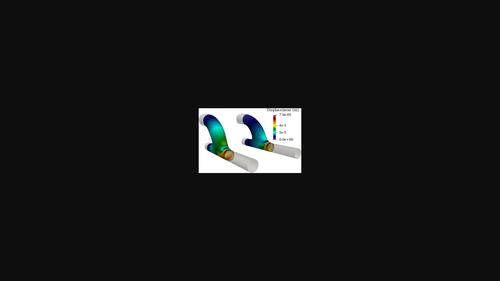当前位置:
X-MOL 学术
›
Int. J. Numer. Methods Fluids
›
论文详情
Our official English website, www.x-mol.net, welcomes your feedback! (Note: you will need to create a separate account there.)
Adjoint shape sensitivities of blood flows considering non-Newtonian properties
International Journal for Numerical Methods in Fluids ( IF 1.8 ) Pub Date : 2023-07-14 , DOI: 10.1002/fld.5227 Georgios Bletsos 1 , Niklas Kühl 1 , Thomas Rung 1
International Journal for Numerical Methods in Fluids ( IF 1.8 ) Pub Date : 2023-07-14 , DOI: 10.1002/fld.5227 Georgios Bletsos 1 , Niklas Kühl 1 , Thomas Rung 1
Affiliation

|
This article discusses the derivation and numerical implementation of an adjoint system, to the primal Navier–Stokes equations, for the computation of shape sensitivities of ducted blood flows considering non-Newtonian fluid properties. The ever-growing advancements in blood flow simulations are, naturally, accompanied by an increased interest in the optimization of related medical devices. In the majority of the computational studies, the Newtonian assumption is used to describe the rheology of blood. While this assumption has been shown to satisfactorily capture the flow when it is governed by high shear rates, it falls short at low shear rates. A rich variety of viscosity models has been proposed to tackle this shortcoming. In this article we show how such models can be incorporated into an adjoint system targeting to produce the shape sensitivity which can be used by a gradient-based optimization method for the minimization of an objective functional. A general formulation of the adjoint equations is proposed, in which contributions of the non-Newtonian properties explicitly occur. The numerical implementation is discussed and the validity of the method is assessed by means of numerical experiments of steady blood flows in a 2D stenosed duct, where results are compared against second-order finite-difference (FD) studies. The proposed methodology is then applied to CAD-free, gradient-based shape optimizations of an idealized 3D arterial bypass-graft operating at three relevant Reynolds numbers. It is observed that the impact of the adjoint viscosity treatment is amplified in low shear-rate flow regimes while fades for higher shear-rates, analogous to its primal counterpart.
中文翻译:

考虑非牛顿特性的血流伴随形状敏感性
本文讨论了原始纳维-斯托克斯方程的伴随系统的推导和数值实现,用于计算考虑非牛顿流体特性的管道血流的形状敏感性。血流模拟的不断进步自然伴随着人们对相关医疗设备优化的兴趣的增加。在大多数计算研究中,牛顿假设用于描述血液的流变学。虽然这一假设已被证明在受高剪切速率控制时可以令人满意地捕获流动,但在低剪切速率下却无法实现。为了解决这个缺点,人们提出了各种各样的粘度模型。在本文中,我们展示了如何将此类模型合并到以产生形状敏感性为目标的伴随系统中,该形状敏感性可通过基于梯度的优化方法用于最小化目标函数。提出了伴随方程的一般公式,其中明确出现了非牛顿性质的贡献。讨论了数值实现,并通过二维狭窄导管中稳定血流的数值实验评估了该方法的有效性,其中结果与二阶有限差分(FD)研究进行了比较。然后将所提出的方法应用于在三个相关雷诺数下运行的理想化 3D 动脉旁路移植物的无 CAD、基于梯度的形状优化。据观察,伴随粘度处理的影响在低剪切速率流动状态下被放大,而在较高剪切速率下则减弱,类似于其原始对应物。
更新日期:2023-07-14
中文翻译:

考虑非牛顿特性的血流伴随形状敏感性
本文讨论了原始纳维-斯托克斯方程的伴随系统的推导和数值实现,用于计算考虑非牛顿流体特性的管道血流的形状敏感性。血流模拟的不断进步自然伴随着人们对相关医疗设备优化的兴趣的增加。在大多数计算研究中,牛顿假设用于描述血液的流变学。虽然这一假设已被证明在受高剪切速率控制时可以令人满意地捕获流动,但在低剪切速率下却无法实现。为了解决这个缺点,人们提出了各种各样的粘度模型。在本文中,我们展示了如何将此类模型合并到以产生形状敏感性为目标的伴随系统中,该形状敏感性可通过基于梯度的优化方法用于最小化目标函数。提出了伴随方程的一般公式,其中明确出现了非牛顿性质的贡献。讨论了数值实现,并通过二维狭窄导管中稳定血流的数值实验评估了该方法的有效性,其中结果与二阶有限差分(FD)研究进行了比较。然后将所提出的方法应用于在三个相关雷诺数下运行的理想化 3D 动脉旁路移植物的无 CAD、基于梯度的形状优化。据观察,伴随粘度处理的影响在低剪切速率流动状态下被放大,而在较高剪切速率下则减弱,类似于其原始对应物。



























 京公网安备 11010802027423号
京公网安备 11010802027423号